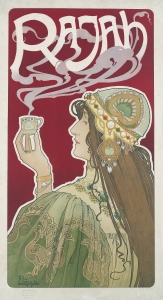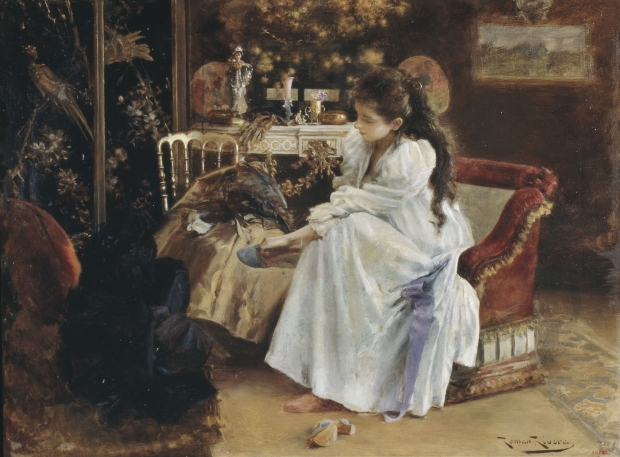The collection of the Museu Nacional d’Art de Catalunya conserves a large number of works in which the image of the woman takes on a major prominence, and becomes an authentic advertising claim. Far from perpetuating the most conventional iconic stereotype that projected a fixed cultural cliché, which associated the woman with certain maternal behaviour or household chores, the modern poster uncovers new facets of the female condition, which until then had been little explored. Coinciding with the end of the 19th century, this cultural and social transformation became intensified and the artists reflected in the new female models: decadence and symbolism helped to forge an aesthetic attitude, sublimating the female figures as a source of escape from an unsatisfactory reality.
The claim for idleness
The protagonists adopt, without any type of shame or modesty, an indolent attitude, of abandonment, busily carrying out leisure activities and amusing themselves in the pleasure of delicious idleness, or dolce far niente. In this way, the poster Cigarrillos Paris becomes one of the examples that sums up best the success of the aesthetic movement in which a woman, engaged in the act of smoking in absolute delight, turns into the necessary accomplice for achieving the advertising goals pursued. Visually, the message appears strengthened by the effect caused by the smoke given off by the burning cigarette.
The whimsical motif of a column that takes on the corporeal shape is a very frequent resource in advertising language. There are other posters in which we see the same effect caused by a rising column of smoke that, in these other examples, come from a cup of tea, coffee or chocolate.
Orientalist sensuality
The escapist background, which comes from orientalist painting, with the odalisque being its main emblem, is part of a very contemporary context, which incorporates the novelties of the modern times. The refinement, elegance, flirting, or sophistication of the protagonists provide an example of some of the new values that cultivated women. In this way, fashion, with its changing tastes and a wide range of products to boost the self esteem and social recognition, is one of the indicators of the rooting of a new culture in which beauty occupies a central space.
The construction of this female model is not unique to advertising posters. Painting includes very representative examples of this iconography. Thus, the orientalist influence is very present from the Romanesque times onwards, and productions such as The odalisque by Mariano Fortuny, a work from 1861, despite its dependence on the literary sources, emerges as one of the first and most notable examples of productions of these characteristics. Without intending to do so, Fortuny would encode the stereotype of the orientalist dream, personified by the image of sensual women, displaying their nakedness without any modesty. Within the context of a puritan society, which only accepted nudity if it was part of a biblical narrative or if it appeared concealed in a mythological scene, it is easy to understand that the critics didn’t see with complacency the exhibition of a work that was too transgressive.
The illnesses of the soul
Curiously, hardly two decades later, the painters from the period of the Bourbon Restoration, active in Catalonia during the Gold Rush (La Febre d’Or), turned the woman into one of the most recurrent motifs of pictorial practice. If we disregard the anecdotal and literary sense of the scenes, or the environmentally decorative nature, many productions by Ramon Casas, like the Portrait of Isabel Llorach (1901), are still indebted to the type of woman that transmits elegance, sophistication, and high social standing.
However, there coexist other female models in which the euphoric joie de vivre is replaced by a state of melancholy, of existential detachment, which is added to a woman in a state of depression, of deep sadness, unable to cope with the daily shores. This strange illness that obeys metaphysical rather than physical causes, known by the poetic term of spleen, coined by Charles Baudelaire, has become an emblem of modernity.
Related links
Exhibition catalogue: El cartell modern a les col·leccions del Museu Nacional d’Art de Catalunya
Exhibition catalogue: Ramon Casas. El pintor del modernismo
Gabinet de Dibuixos i Gravats















2 Comments
A very interesting blog with a high vocabulary level. BUT… and it is a big BUT!. There are grammatical errors in the English (clearly not the native language of the translator).
Would you like me to correct these errors and those in any future posts? Do you want to have perfectly written posts.
Copywriting and editing is my work so you would not be dealing with an amateur. Send me an email and give it a try! You have nothing to lose and everything to gain.
Best regards
Peter
Thank you very much, Peter, for your interest and the comments you make about the English of our blog. As we are sure you are well aware, translations are not an exact science, but we nevertheless try and do our best to guarantee the quality of the translations, with the aim of making sure that the overall meaning is the same as the original. We have nevertheless passed on your comments to our translators so as to take them into account.